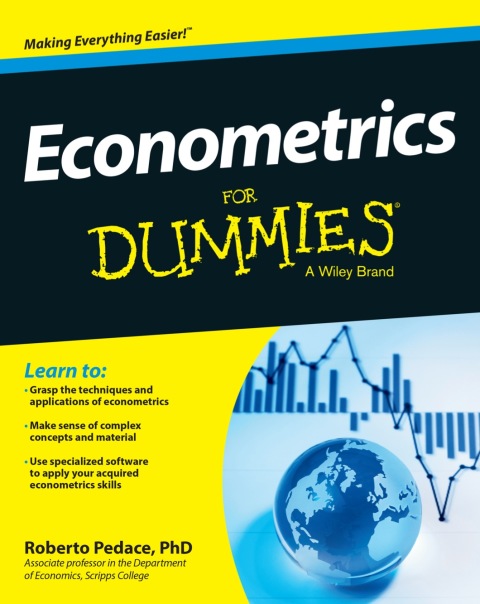Description
Efnisyfirlit
- About the Author
- Contents at a Glance
- Table of Contents
- Introduction
- About This Book
- Foolish Assumptions
- Icons Used in This Book
- Beyond the Book
- Where to Go from Here
- Part I: Getting Started with Econometrics
- Chapter 1: Econometrics: The Economist’s Approach to Statistical Analysis
- Evaluating Economic Relationships
- Applying Statistical Methods to Economic Problems
- Using Econometric Software: An Introduction to STATA
- Chapter 2: Getting the Hang of Probability
- Reviewing Random Variables and Probability Distributions
- Understanding Summary Characteristics of Random Variables
- Chapter 3: Making Inferences and Testing Hypotheses
- Getting to Know Your Data with Descriptive Statistics
- Laying the Groundwork of Prediction with the Normal and Standard Normal Distributions
- Working with Parts of the Population: Sampling Distributions
- Making Inferences and Testing Hypotheses with Probability Distributions
- Part II: Building the Classical Linear Regression Model
- Chapter 4: Understanding the Objectives of Regression Analysis
- Making a Case for Causality
- Getting Acquainted with the Population Regression Function (PRF)
- Collecting and Organizing Data for Regression Analysis
- Chapter 5: Going Beyond Ordinary with the Ordinary Least Squares Technique
- Defining and Justifying the Least Squares Principle
- Estimating the Regression Function and the Residuals
- Obtaining Estimates of the Regression Parameters
- Interpreting Regression Coefficients
- Measuring Goodness of Fit
- Chapter 6: Assumptions of OLS Estimation and the Gauss-Markov Theorem
- Characterizing the OLS Assumptions
- Relying on the CLRM Assumptions: The Gauss-Markov Theorem
- Chapter 7: The Normality Assumption and Inference with OLS
- Describing the Role of the Normality Assumption
- Testing the Significance of Individual Regression Coefficients
- Analyzing Variance to Determine Overall or Joint Significance
- Applying Forecast Error to OLS Predictions
- Part III: Working with the Classical Regression Model
- Chapter 8: Functional Form, Specification, and Structural Stability
- Employing Alternative Functions
- Giving Linearity to Nonlinear Models
- Checking for Misspecification
- Chapter 9: Regression with Dummy Explanatory Variables
- Numbers Please! Quantifying Qualitative Information
- Finding Average Differences by Using a Dummy Variable
- Combining Quantitative and Qualitative Data in the Regression Model
- Interacting Quantitative and Qualitative Variables
- Interacting Two (or More) Qualitative Characteristics
- Segregate and Integrate: Testing for Significance
- Part IV: Violations of Classical Regression Model Assumptions
- Chapter 10: Multicollinearity
- Distinguishing between the Types of Multicollinearity
- Rules of Thumb for Identifying Multicollinearity
- Knowing When and How to Resolve Multicollinearity Issues
- Chapter 11: Heteroskedasticity
- Distinguishing between Homoskedastic and Heteroskedastic Disturbances
- Detecting Heteroskedasticity with Residual Analysis
- Correcting Your Regression Model for the Presence of Heteroskedasticity
- Chapter 12: Autocorrelation
- Examining Patterns of Autocorrelation
- Illustrating the Effect of Autoregressive Errors
- Analyzing Residuals to Test for Autocorrelation
- Remedying Harmful Autocorrelation
- Part V: Discrete and Restricted Dependent Variables in Econometrics
- Chapter 13: Qualitative Dependent Variables
- Modeling Discrete Outcomes with the Linear Probability Model (LPM)
- Presenting the Three Main LPM Problems
- Specifying Appropriate Nonlinear Functions: The Probit and Logit Models
- Using Maximum Likelihood (ML) Estimation
- Interpreting Probit and Logit Estimates
- Chapter 14: Limited Dependent Variable Models
- The Nitty-Gritty of Limited Dependent Variables
- Modifying Regression Analysis for Limited Dependent Variables
- Part VI: Extending the Basic Econometric Model
- Chapter 15: Static and Dynamic Models
- Using Contemporaneous and Lagged Variables in Regression Analysis
- Projecting Time Trends with OLS
- Using OLS for Seasonal Adjustments
- Chapter 16: Diving into Pooled Cross-Section Analysis
- Adding a Dynamic Time Element to the Mix
- Using Experiments to Estimate Policy Effects with Pooled Cross Sections
- Chapter 17: Panel Econometrics
- Estimating the Uniqueness of Each Individual Unit
- Increasing the Efficiency of Estimation with Random Effects
- Testing Efficiency against Consistency with the Hausman Test
- Part VII: The Part of Tens
- Chapter 18: Ten Components of a Good Econometrics Research Project
- Introducing Your Topic and Posing the Primary Question of Interest
- Discussing the Relevance and Importance of Your Topic
- Reviewing the Existing Literature
- Describing the Conceptual or Theoretical Framework
- Explaining Your Econometric Model
- Discussing the Estimation Method(s)
- Providing a Detailed Description of Your Data
- Constructing Tables and Graphs to Display Your Results
- Interpreting the Reported Results
- Summarizing What You Learned
- Chapter 19: Ten Common Mistakes in Applied Econometrics
- Failing to Use Your Common Sense and Knowledge of Economic Theory
- Asking the Wrong Questions First
- Ignoring the Work and Contributions of Others
- Failing to Familiarize Yourself with the Data
- Making It Too Complicated
- Being Inflexible to Real-World Complications
- Looking the Other Way When You See Bizarre Results
- Obsessing over Measures of Fit and Statistical Significance
- Forgetting about Economic Significance
- Assuming Your Results Are Robust
- Appendix: Statistical Tables
- The Standard Normal Distribution
- t-Distribution
- Chi-Squared Distribution
- F-Distribution
- Durbin-Watson d-Statistic
- Index






Reviews
There are no reviews yet.